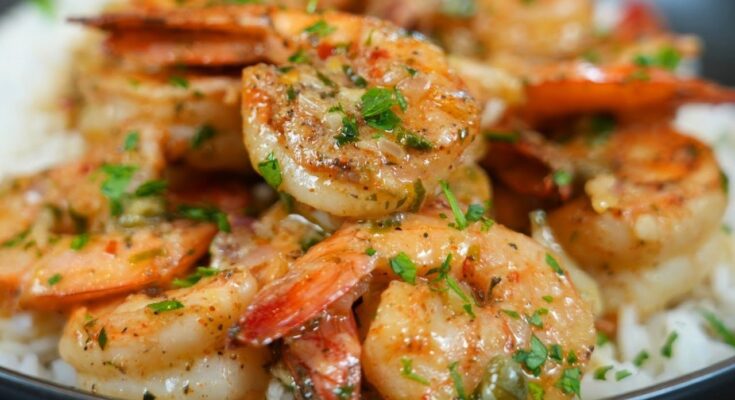Shrimp Recipe: Shrimp is one of the most versatile and flavorful seafood options, perfect for quick dinners, appetizers, and gourmet meals. It’s low in calories, high in protein, and rich in essential nutrients. Whether pan-fried, grilled, or baked, shrimp is easy to prepare and can be customized to suit various cuisines.
In this guide, we’ll walk you through a simple yet delicious shrimp recipe. From cleaning and marinating to cooking and serving, we’ve got all the steps covered.
Let’s dive into this mouthwatering seafood delight!
Ingredients Needed for Shrimp Recipe
Essential Ingredients:
- Fresh Shrimp (1 lb) – Peeled and deveined.
- Olive Oil (2 tbsp) – For cooking and marinating.
- Garlic (4 cloves, minced) – Adds aromatic flavor.
- Lemon Juice (2 tbsp) – Provides tanginess.
- Salt and Pepper (to taste) – Enhances flavor.
- Paprika (1 tsp) – Adds a smoky touch.
- Butter (2 tbsp) – For rich texture.
- Parsley (2 tbsp, chopped) – For garnish.
Optional Add-ons:
- Red Chili Flakes (½ tsp) – For spice lovers.
- Honey (1 tbsp) – Adds sweetness.
- White Wine (2 tbsp) – Enhances flavor depth.
- Soy Sauce (1 tbsp) – Adds umami flavor.
Having the right ingredients ensures a balanced taste and makes cooking shrimp a breeze.
Tools and Equipment Required
Before we begin, ensure you have the following kitchen tools ready:
- Cutting Board and Knife – For cleaning and deveining shrimp.
- Mixing Bowls – For marinating and mixing sauces.
- Skillet or Frying Pan – For cooking shrimp.
- Grill or Oven (optional) – For alternative cooking methods.
- Tongs or Spatula – For flipping shrimp.
- Measuring Spoons and Cups – For precise measurements.
- Paper Towels – For drying shrimp before cooking.
Proper preparation with the right tools will make cooking hassle-free.
Step 1: Cleaning and Preparing the Shrimp
How to Clean Shrimp Properly?
- Rinse the Shrimp – Place the shrimp under cold running water to wash off dirt or grit.
- Peel the Shell – Start by removing the shell from the body, leaving the tail intact for presentation if desired.
- Remove the Legs – Peel off the small legs that are attached to the underside.
Deveining Tips:
- Use a Small Knife or Deveiner Tool – Make a shallow cut along the back of the shrimp.
- Remove the Black Vein – Pull out the dark vein with the tip of the knife or your fingers.
- Rinse Again – Wash the shrimp thoroughly after deveining.
Proper cleaning ensures the shrimp is ready for marinating and cooking without any unwanted grittiness.
Step 2: Marinating the Shrimp
Best Marinades for Flavor:
A good marinade infuses shrimp with rich flavors. Here’s a quick marinade recipe:
- Olive Oil (2 tbsp)
- Minced Garlic (2 cloves)
- Lemon Juice (2 tbsp)
- Paprika (1 tsp)
- Salt and Pepper (to taste)
Marinating Time and Techniques:
- Combine all the ingredients in a mixing bowl.
- Add the cleaned shrimp and toss well to coat evenly.
- Cover the bowl and refrigerate for 15–30 minutes to let the flavors soak in.
Avoid over-marinating, as shrimp can become mushy if left too long in acidic mixtures.
Step 3: Cooking Methods for Shrimp
Pan-Frying Shrimp:
- Heat 2 tablespoons of olive oil in a skillet over medium-high heat.
- Add marinated shrimp in a single layer.
- Cook for 2–3 minutes per side until they turn pink and opaque.
- Remove from the pan and set aside.
Grilling Shrimp:
- Preheat the grill to medium-high heat.
- Skewer shrimp for easy grilling.
- Grill each side for 2–3 minutes, brushing with marinade for added flavor.
Boiling or Steaming Shrimp:
- Bring a pot of water to a boil and season with salt and lemon slices.
- Add shrimp and boil for 2–3 minutes until pink.
- Drain and serve immediately.
Each method offers a unique flavor and texture, so feel free to experiment!
Step 4: Making Shrimp Sauce and Seasoning
Classic Garlic Butter Sauce Recipe:
- Melt 2 tablespoons of butter in a pan.
- Add 3 cloves of minced garlic and sauté for 30 seconds.
- Stir in lemon juice (1 tbsp) and parsley (1 tbsp).
- Drizzle over shrimp before serving.
Spicy Chili Sauce Recipe:
- Mix hot sauce (2 tbsp), honey (1 tbsp), and garlic powder (½ tsp).
- Toss shrimp in the sauce after cooking for a spicy kick.
Step 5: Plating and Garnishing Shrimp
Presentation matters just as much as flavor. A beautifully plated dish not only pleases the eyes but also enhances the dining experience.
Plating Tips:
- Choose the Right Plate:
- Opt for a white or neutral-colored plate to make the shrimp stand out.
- Use wide, flat plates for a more elegant presentation.
- Layer the Shrimp:
- Arrange the shrimp in a circular or layered pattern.
- Leave space between the pieces for a clean look.
- Add Garnishes:
- Sprinkle fresh parsley or cilantro for color.
- Add a wedge of lemon or lime for garnish and extra flavor.
- Drizzle Sauce Over the Top:
- Lightly drizzle the prepared sauce over the shrimp or serve it in a small side bowl for dipping.
- Include Side Elements:
- Pair shrimp with a small salad, rice pilaf, or toasted bread slices to complete the look.
A well-presented dish can turn a simple meal into a gourmet experience!
Alternative Shrimp Recipes
If you’re looking to experiment, here are some popular shrimp variations:
1. Shrimp Scampi:
- Cook shrimp in garlic butter and white wine sauce.
- Serve over pasta or rice for a hearty meal.
2. Shrimp Alfredo:
- Toss cooked shrimp in creamy Alfredo sauce.
- Serve with fettuccine pasta and parmesan cheese.
3. Cajun Shrimp:
- Season shrimp with Cajun spices and pan-fry for a spicy kick.
- Pair with cornbread or mashed potatoes.
These recipes highlight shrimp’s versatility, making it suitable for all tastes and occasions.
Serving Suggestions
Shrimp pairs wonderfully with a variety of side dishes, allowing you to create balanced meals.
Best Side Dishes for Shrimp:
- Rice Dishes:
- Garlic butter rice or lemon herb rice complement shrimp flavors.
- Pasta Options:
- Spaghetti, linguine, or fettuccine work great with creamy or garlic-based shrimp sauces.
- Vegetable Sides:
- Grilled asparagus, roasted broccoli, or sautéed spinach add freshness.
- Bread Choices:
- Serve with garlic bread, baguettes, or flatbreads for dipping into sauces.
- Salads:
- A Caesar salad or Greek salad pairs perfectly with shrimp dishes.
Mix and match to create your ideal shrimp platter!
Nutritional Benefits of Shrimp
Shrimp is not only delicious but also packed with nutrients.
Health Advantages:
- High in Protein: Shrimp provides about 20 grams of protein per 3-ounce serving, making it a great option for muscle building.
- Low in Calories: With only 84 calories per serving, it’s ideal for weight loss diets.
- Rich in Nutrients: Contains selenium, vitamin B12, and iodine, which support thyroid health.
- Heart-Healthy Omega-3s: Promotes cardiovascular health and reduces inflammation.
Dietary Considerations:
- Low Carb and Gluten-Free: Suitable for keto and gluten-free diets.
- Low in Mercury: Safe for regular consumption compared to other seafood.
This makes shrimp an excellent choice for healthy and balanced meals.
Common Mistakes to Avoid While Cooking Shrimp
Even experienced cooks can make errors when preparing shrimp. Here are some common pitfalls:
- Overcooking:
- Shrimp cooks very quickly. Overcooking can make it rubbery.
- Cook just until it turns pink and opaque.
- Skipping Deveining:
- Leaving the vein intact can lead to grit and an unpleasant texture. Always devein shrimp before cooking.
- Not Drying Shrimp Before Cooking:
- Wet shrimp won’t sear properly. Pat them dry with paper towels before adding to a hot pan.
- Using Too Much Marinade:
- Excess liquid can prevent browning. Use just enough marinade to coat shrimp lightly.
- Cooking Shrimp Straight from Frozen:
- Always thaw frozen shrimp before cooking to ensure even cooking and better flavor absorption.
Avoiding these mistakes guarantees perfect shrimp every time!
Tips for Buying Fresh Shrimp
Fresh vs. Frozen Shrimp:
- Fresh Shrimp:
- Look for shrimp with a mild ocean scent, firm texture, and translucent shells.
- Avoid shrimp with black spots or slimy surfaces.
- Frozen Shrimp:
- Opt for individually quick-frozen (IQF) shrimp for better quality.
- Ensure no ice crystals, as they indicate freezer burn.
Recognizing Quality Shrimp:
- The shells should be intact, and the flesh should bounce back when pressed.
- Wild-caught shrimp are often more flavorful than farm-raised ones.
Whether fresh or frozen, proper selection guarantees great taste and texture.
Storing and Reheating Shrimp Leftovers
Best Storage Practices:
- Refrigerate Immediately: Place leftover shrimp in an airtight container and store it in the fridge for up to 3 days.
- Freeze for Long-Term Storage: Store cooked shrimp in freezer bags for up to 3 months.
Reheating Without Overcooking:
- Microwave Method: Use short bursts of 15–20 seconds to prevent overcooking.
- Skillet Method: Reheat over medium heat with a splash of water or butter for added moisture.
- Oven Method: Warm at 300°F (150°C) for 5–10 minutes in foil.
Proper storage and reheating retain flavor and texture without making shrimp rubbery.
FAQs about Shrimp Recipes
1. What types of shrimp can I use for cooking?
You can use various types of shrimp in cooking, including fresh or frozen, raw or pre-cooked. Popular types include tiger shrimp, white shrimp, and pink shrimp. Ensure they are properly cleaned and deveined before cooking.
2. How do I know when shrimp are cooked?
Shrimp cook quickly and are done when their color turns pink and their bodies curl into a C-shape. Be careful not to overcook as they can become rubbery.
3. Can I cook shrimp from frozen?
Yes, you can cook shrimp from frozen. It’s a convenient option that doesn’t require thawing; however, cooking time might be slightly longer compared to fresh shrimp.
4. What are some healthy ways to cook shrimp?
Healthy cooking methods include grilling, broiling, sautéing, and steaming. These techniques help retain the delicate flavor and texture of shrimp while minimizing the use of fats.
5. What are some common spices and herbs that go well with shrimp?
Garlic, lemon, parsley, and chives enhance the natural flavor of shrimp. For a bit of heat, add spices like paprika or a dash of cayenne pepper.
6. How can I prevent shrimp from becoming tough and chewy?
Avoid overcooking shrimp, as they can quickly become tough. Cooking them on medium-high heat for just a few minutes per side is generally sufficient.
7. What are some popular shrimp recipes?
Popular shrimp recipes include shrimp scampi, grilled shrimp, shrimp tacos, and shrimp pasta dishes. These dishes can be tailored with various seasonings and ingredients to suit different tastes.
8. Can shrimp be used in diet plans?
Shrimp is a great addition to many diet plans as it’s high in protein and low in calories. It’s suitable for ketogenic, paleo, and low-carb diets.
9. Are there any allergen concerns with shrimp?
Shrimp is a common allergen, part of the shellfish category. If you have a shellfish allergy, it’s essential to avoid shrimp and seek alternative protein sources.
10. How should I store shrimp?
Store uncooked shrimp in the coldest part of your refrigerator and use within two days, or freeze them. Cooked shrimp can be refrigerated for up to three days and should be stored in an airtight container.
Conclusion
Cooking shrimp doesn’t have to be intimidating. By following this step-by-step guide, you’ll master everything from cleaning and marinating to cooking and serving. Whether you prefer grilled, pan-fried, or boiled shrimp, there are endless ways to prepare this delicious seafood.
Pair it with your favorite sides, experiment with sauces, and don’t forget to garnish for the perfect presentation. Shrimp is quick, nutritious, and versatile—perfect for any meal!



